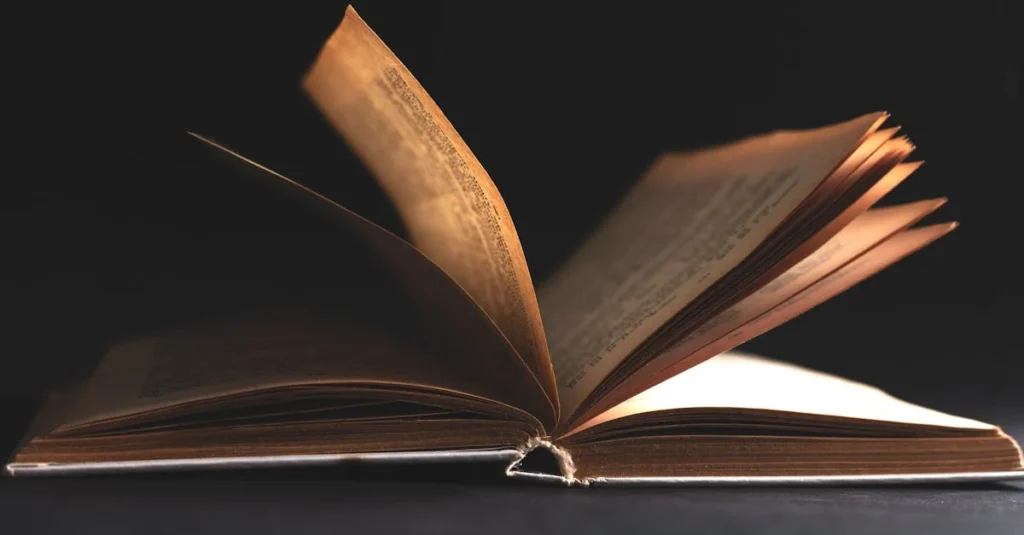Nonfiction writing examples opens a window to the real world, offering insights into facts, experiences, and truths that shape our understanding. Whether it’s a gripping memoir, an enlightening essay, or a detailed how-to guide, nonfiction serves as a powerful tool for communication and education. I’ve always been fascinated by how diverse this genre can be, showcasing a range of styles and purposes.
In this article, I’ll explore various examples of nonfiction writing that not only inform but also inspire. From the personal narratives that tug at our heartstrings to the investigative pieces that challenge our perceptions, there’s so much to discover. Join me as I delve into the richness of nonfiction and uncover what makes these examples stand out in the literary landscape.
Key Takeaways
- Nonfiction writing examples encompasses various forms, including memoirs, essays, biographies, and how-to guides, each serving distinct educational and communicative purposes.
- Memoirs provide personal insights and stories, enabling readers to connect emotionally with the author’s experiences and lessons learned.
- Essays stimulate critical thinking by presenting arguments and reflections, while articles focus on factual reporting to inform readers about current events and trends.
- Research and narrative structure are essential techniques in nonfiction writing, enhancing clarity, engagement, and credibility.
- Notable examples of nonfiction, such as “The Diary of a Young Girl” and “Educated,” illustrate the genre’s capacity to inspire, educate, and foster empathy.
- Nonfiction writing plays a crucial role in shaping societal perspectives and promoting understanding through factual storytelling and personal narratives.
Nonfiction Writing Examples
Nonfiction writing examples encompasses various forms that aim to convey factual information and real experiences. This genre includes memoirs, essays, articles, biographies, and how-to guides. Each form serves distinct purposes, such as educating readers or sharing personal experiences.
Memoirs provide a glimpse into an individual’s life, allowing readers to connect with personal stories and lessons learned. Essays present arguments or reflections on specific topics, encouraging critical thinking and exploration of ideas. Articles deliver information on current events, scientific discoveries, or cultural phenomena, promoting awareness and understanding.
How-to guides offer practical advice, equipping readers with skills or knowledge for specific tasks. This diversity in forms highlights nonfiction’s unique strengths in communication and education, appealing to a broad audience. By exploring these examples, I aim to reveal the richness of nonfiction writing and its impact on readers’ lives.
Types of Nonfiction Writing
Nonfiction writing encompasses various forms, each serving distinct purposes while effectively conveying real experiences and truths. Below are key types of nonfiction writing that illustrate this genre’s diversity.
Memoirs and Autobiographies
Memoirs and autobiographies both narrate personal experiences, but they differ in scope. Memoirs focus on specific life events or themes, providing insight into emotions and lessons learned. For example, “The Glass Castle” by Jeannette Walls highlights her unconventional upbringing, crafting a compelling narrative from chosen memories. Autobiographies typically cover an entire life story chronologically. A well-known example is “The Diary of a Young Girl” by Anne Frank, which chronicles her experiences during WWII.
Essays and Articles
Essays and articles communicate ideas, arguments, or information on various topics. Essays often express the author’s perspective and evoke critical thinking. “A Modest Proposal” by Jonathan Swift serves as a satirical essay addressing complex social issues. Articles, on the other hand, focus on factual reporting and current events. For instance, journalistic pieces from The New York Times inform readers about politics, culture, and societal trends, aiming to keep the public updated and engaged.
Biographies
Biographies offer comprehensive accounts of individuals’ lives, detailing their achievements, struggles, and impact on society. These works provide context and analysis of a person’s influence, illuminating historical or cultural significance. A notable biography is “Alexander Hamilton” by Ron Chernow, which explores the life of one of America’s Founding Fathers, emphasizing his contributions to the nation’s formation.
Travel Writing
Travel writing shares firsthand experiences of different cultures, landscapes, and adventures. This genre transports readers to new places and immerses them in diverse environments. Books like “Eat, Pray, Love” by Elizabeth Gilbert combine personal journeys with rich descriptions of destinations, inviting readers to explore foreign experiences vicariously. Travel writing not only describes locations but also reflects the author’s insights and emotional connections to those places.
Notable Nonfiction Writing Examples
Nonfiction writing encompasses a range of styles and techniques, each offering unique insights. Below are notable examples that illustrate the genre’s versatility and impact.
Classic Examples
- “The Diary of a Young Girl” by Anne Frank – This poignant memoir captures Anne’s experiences hiding from the Nazis during World War II. Her reflections reveal the depths of human spirit amid adversity.
- “A Brief History of Time” by Stephen Hawking – This book simplifies complex concepts in cosmology. Hawking’s clear explanations of the universe’s beginnings allow readers to engage with profound scientific principles.
- “The Elements of Style” by William Strunk Jr. and E.B. White – This essential guide provides foundational rules of English writing. Its concise tips on grammar and composition enhance clarity and effectiveness in writing.
- “The Autobiography of Malcolm X” by Malcolm X and Alex Haley – This powerful narrative chronicles Malcolm X’s journey from hardship to activism. It explores themes of race, identity, and social justice, resonating with readers across generations.
- “Educated” by Tara Westover – This memoir details Westover’s quest for knowledge despite growing up in a strict and isolated household. Her journey underscores the transformative power of education.
- “Sapiens: A Brief History of Humankind” by Yuval Noah Harari – Harari’s work offers a sweeping overview of human history. It examines the evolution of societies and cultures, prompting readers to contemplate humanity’s future.
- “Becoming” by Michelle Obama – This autobiography reflects Obama’s life journey, from her childhood to her role as First Lady. Her candid storytelling resonates with themes of resilience and empowerment.
- “The Immortal Life of Henrietta Lacks” by Rebecca Skloot – This investigative piece intertwines the story of Henrietta Lacks with the ethical issues of medical research. Skloot’s compelling narrative sheds light on race, ethics, and scientific advancement.
Techniques in Nonfiction Writing
Nonfiction writing employs various techniques aimed at enhancing clarity, engagement, and impact. Among these techniques, research and narrative structure play critical roles in ensuring the authenticity and flow of the content.
Research and Fact-Checking
Research forms the backbone of nonfiction writing. Accurate information enhances credibility and informs readers. I prioritize using reliable sources, such as academic journals, reputable news outlets, and expert interviews, to substantiate claims. Fact-checking ensures I present truthful statements that align with the research findings. For instance, referencing statistical data requires verification against primary sources to maintain integrity. This rigorous approach builds trust with readers, fostering a deeper engagement with the material.
Narrative Structure
Narrative structure in nonfiction writing organizes information effectively, guiding readers through the content. I often employ a chronological format for biographies and memoirs, allowing readers to follow the subjects’ journeys seamlessly. In essays, I utilize thematic organization to explore different facets of a subject, making complex ideas more digestible. For articles, I apply the inverted pyramid structure, placing the most crucial information at the beginning, which captures attention and delivers key insights quickly. This strategic arrangement enhances clarity, making the reading experience both enjoyable and informative.
Impact of Nonfiction Writing
Nonfiction writing shapes perspectives and informs opinions. Through factual storytelling, it engages readers in crucial conversations about society, history, and the human experience.
Nonfiction writing fosters awareness and understanding. Memoirs, for instance, reveal personal stories that resonate with readers, promoting empathy and compassion. Essays challenge us to think critically, driving discussions around complex topics. Articles deliver timely information on events and trends, aiding informed decision-making.
Nonfiction also serves as a powerful educational tool. How-to guides provide step-by-step instructions, empowering readers to develop skills in various areas, from cooking to self-improvement. Travel writing immerses audiences in diverse cultures and landscapes, broadening their worldview.
The impact of nonfiction writing extends to personal growth. Engaging with different voices and experiences encourages reflection and introspection. Lives change as readers connect with the lessons shared in memoirs like “Educated” by Tara Westover or “Becoming” by Michelle Obama, inspiring them to pursue their own journeys of self-discovery.
Nonfiction writing underscores the importance of credibility. When authors prioritize research and fact-checking, they build trust with their audience. Credible sources enhance the impact of articles and essays, establishing writers as authorities in their fields. This trust fosters deeper connections between readers and the material, amplifying its meaning and relevance.
Ultimately, nonfiction writing holds immense potential to influence thought, behavior, and societal norms. It not only reflects reality but also has the power to shape it.
Writing Examples
Nonfiction writing examples is a powerful tool that shapes our understanding of the world. It connects us through shared experiences and diverse perspectives. I believe engaging with various forms of nonfiction not only informs but also inspires personal growth.
As I explore more examples of this genre, I’m continually amazed at how nonfiction can spark critical conversations and foster empathy. Whether it’s a memoir that resonates with my own journey or an article that sheds light on current issues, each piece has the potential to leave a lasting impact.
I encourage you to dive into nonfiction writing and discover its richness. You’ll find that it not only enhances your knowledge but also deepens your connection to the human experience.

